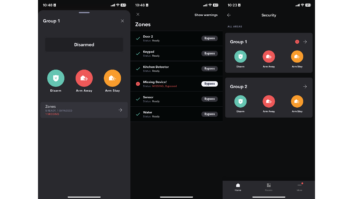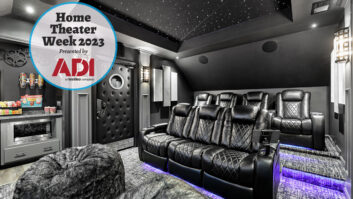Naples, Florida, is considered one of the hottest spots in the country in which to live. New homeowners moving to the area expect all the modern conveniences that technology has to offer, and the market for luxury homes has grown rapidly in the area. Custom installation specialists, for their part, are called upon to design fully automated systems for lighting, security and communication as well as multimedia rooms and home theaters.
This past year the Dream Home 2001, a technology-driven house of the future, was open to the public at Quail West Golf & Country Club in Naples for an eight-week period and 20,000 people lined up to get a look at the $8.3 million, 8,500-square-foot luxury home. The project was a collaborative effort led by the design and construction firm, London Bay Homes, and included an interior designer, a landscape architect and a systems integrator, Integrated Electronic Environments (IE2). Dream Homes have been built in the area before, but this was the first time that a systems integrator was asked to bring its expertise to the table.
IE2 designed and installed all the low voltage systems on display in the Dream Home. The house is fully equipped with a Lutron system, an AMX home automation system, an audio distribution system including Speakercraft speakers and amplifiers and Triad in-wall surround speakers; and an audio/video system that includes Sony Flat Screen TVs, HDTV, plasma monitors and a satellite dish. The home theater includes a Seleco Grand Cinema DLP projector and Meridian digital theater speakers as well as digital surround and audio/video processors. The communications system includes Panasonic digital and wireless telephone systems. Middle Atlantic AX-S systems are used throughout the house.
Wayne Kahn, vice president and founder of IE2, says the Naples-based systems integration firm carefully chooses the manufacturers it works with on any given project. “We do not represent 150 manufacturers,” he explained. “We represent an exclusive 10 or 15. AMX and Lutron are the companies we chose to do business with. Audio Access happens to be the company we chose to do the audio distribution system with. We only use Middle Atlantic because they’re the best at what they do.” Before founding IE2 in 1997, Kahn worked for Lutron Electronics where he set up Lutron’s entire dealer networks in Florida, Georgia and the Caribbean. He took a position with a local dealer when he and his wife decided to start a family. He wanted to travel less and be closer to home, but within a short time, one of his long-standing clients, London Bay Homes founder Mark Wilson, offered to help Kahn start his own systems integration business.
“I started IE2 because I called on the people who built high-end homes, and everybody I met with pretty much said, “Wouldn’t it be great if we could call one company who could do everything?” So that’s what we’ve set out to achieve here at IE2,” Kahn said. Running a business can be an all consuming task, and Kahn realized early on that being in charge of the day-to-day operations while at the same time attempting to focus on his area of expertise, sales, would leave him dissatisfied and the company shortchanged. “In order to run a company you either have to stay in the office and worry about what goes on day-to-day, or you’re in sales. It’s very, very difficult to do both. I didn’t have enough time to devote to running the company so I could achieve the best result the way I would have wanted to. About a year and a half ago we brought in John Kiefer to do the day-to-day administration, which has left me able to focus on sales.” Kahn says it’s important to establish a client’s lifestyle wants and needs on an initial consultation. He asks clients what they know about different systems and then explains the different options they might have. In this way both client and systems integrator are on the same page. Once he gets a feel for exactly what the client wants, he’ll make a set of budget estimates based on a rough per square foot quote for the different systems that IE2 will need to design and install.
“When I meet someone I might ask them if they’re interested in lighting design and if they’ve ever been in a house where there’s a good lighting design,” he said. “I talk to them about lighting and the difference between a cheap, junky lighting fixture and a good lighting fixture and what it does and the difference it makes in a house. Once you establish those kinds of parameters with all the systems of a house, then it’s like buying a car–you can buy a Honda or you can buy a Porsche. They both have four wheels and a steering wheel and they both get you from Point A to Point B, but it’s a totally different ride. The clients have to decide what kind of ride they want to take.”
Kahn says that he tries to establish the kind of pricing parameters that a client finds acceptable and then works within that framework. “My goal has always been to deliver back to the client a product in the price range they have requested,” he explained. “If it doesn’t fit within the budget we talked about, I try to explain to them why it’s not in the budget. I’d rather go back to a client with the worst-case scenario. If someone tells you they want to spend $40,000, it’s easier to get them to compromise on a $50,000 budget if you come back and tell them it’s going to cost $60,000. If you go back with a $40,000 proposal it’s a much more difficult task to try to get them to that $50,000.”
Once a project gets underway, Kahn continues to interact with the clients and does jobsite walk-throughs to make sure everything is on schedule. The company currently has 38 full-time employees, including almost 20 custom installers, but uses subcontractors when necessary. Recently, seven full-time subcontractors were called into a jobsite for a 6,900-square-foot home in Palm Beach that the company is currently working on. IE2 does approximately 50 to 60 projects a year and grosses somewhere in the neighborhood of $6 million. “If you do the math, we average about $187,000 per employee which is better than the going rate in this business. It’s normally $100,000 to $125,000,” Kahn said.
He stresses that this is still a new business and predicts many changes in the next few years. Kahn believes the industry will see consolidations and mergers with larger audio/video companies buying out smaller ones and same-size companies with similar interests, but differing areas of expertise, merging together to make one more diverse company.
“In Naples, Florida, there are six dealers in town,” he explains, for example. “Is there enough business for all of us? Absolutely, but in order to become the powerhouse, consolidation will occur.” Kahn is optimistic about his own company’s future. And though clients and manufacturers think of the company as the Rolls Royce of system integrators, according to Kahn, he sees the company moving toward developing systems for the mass market. “Ten years ago, a computer cost $5,000 and only the very wealthy had computers, now anyone can buy a computer for $500 to $600. Ten years ago, cell phones were only seen in the back of limos, and it was assumed they were for the wealthy. Now anyone can afford to buy a cell phone. As technology advances and as the price of technology goes down, I think the more common man will be able to afford some of this technology.” And Kahn and IE2 plan to be there, making everyone’s dreams come true.
–Nancy Caronia is a freelance writer based in Geneva, New York.







